PRINTER FRIENDLY PDF
EPUB
AUDIOBOOK
Abstract: During the Cuban missile crisis, the U.S. Marine Corps deployed a Hawk air defense missile battery from the 3d Light Antiaircraft Missile (LAAM) Battalion to Guantánamo Bay, Cuba, to protect the U.S. naval base from a surprise low-level air attack by Soviet and Cuban aircraft. The battalion was alerted and airlifted from Twentynine Palms, California, to Cherry Point, North Carolina, with its Battery C deployed forward into Cuba. The deployment validated the readiness of the Corps’ LAAM battalions to employ the Hawk system in support of expeditionary forces. However, the story of the LAAM battalions and deployment of 3d LAAM to Guantánamo Bay is not well known or documented because few official records of the LAAM battalions from the early 1960s exist. This article uses Marine Corps Base Twentynine Palms’s newspaper to provide context along with veterans’ first-hand experiences to fill in the details of the LAAM battalions before and during the Cuban missile crisis.
Keywords: Cuban missile crisis, U.S. Marines, 3d Light Antiaircraft Missile Battalion, LAAM, Hawk missile system, Guantánamo Bay
In October 1962, four days after President John F. Kennedy publicly announced that U.S. spy planes had discovered Soviet nuclear missiles in Cuba, a Marine Corps Hawk missile battery—Battery C, 3d Light Antiaircraft Missile (LAAM) Battalion—arrived in Guantánamo Bay to protect the U.S. naval base against a low-level air strike by Soviet and Cuban aircraft. The deployment of Battery C to Cuba was the first contingency deployment of a U.S. Hawk medium-range surface-to-air missile battery outside of the United States and a validation of the Marine Corps’ decision to acquire and field the Hawk missile system. Today, the story of 3d LAAM’s deployment to Guantánamo Bay is largely forgotten, overshadowed by the strategic nature of the Cuban missile crisis and, perhaps, because there are few official records exist from the period about the 3d LAAM Battalion. This article uses coverage in Marine Corps Base Twentynine Palms’s newspaper to provide context and first-hand experiences of several veterans to fill in details about the 3d LAAM Battalion before and during the Cuban missile crisis.1
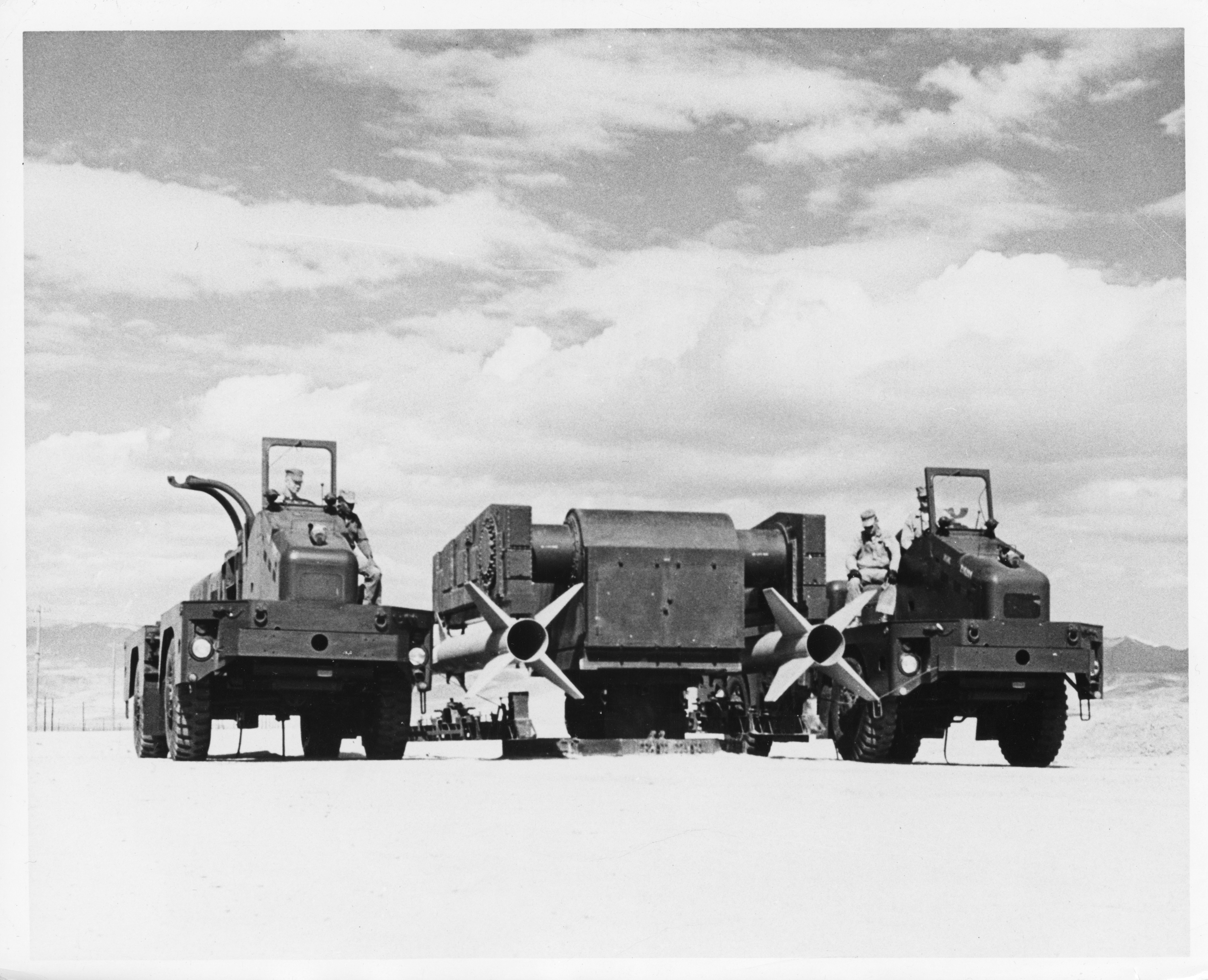
The Marine Corps’ first missile air defense system was the Terrier. Seen here, four Marines transfer missiles from a wheeled missile carrier to a launcher during an exercise at Naval Ordnance Test Station, China Lake, CA. Official Department of Defense photo
Before Hawk, the Marine Corps’ ground-based air defense weapons were the 75mm M51 Skysweeper antiaircraft gun and the Convair RIM-2 Terrier guided missile system. The Skysweeper, a modern gun system at the time, was fielded in the early 1950s by both the U.S. Army and Marine Corps for short-range air defense. Fitted with an autoloader for rapid fire and a radar and computer for fire direction, the gun could engage subsonic aircraft to a range of 9 kilometers (km) and altitude of 5,600 meters (18,600 feet). The Skysweeper was simple to operate and relatively mobile, but by the late 1950s its engagement reaction time was too slow and its range too short to effectively engage new Soviet supersonic aircraft such as the Mikoyan-Gurevich MiG-21. To counter the threat posed by Soviet jets, the Marine Corps acquired the Terrier system, a Navy developed antiaircraft missile system designed for use on board cruisers and then subsequently modified for employment on land.2 Not only were the Terrier’s 12-km range and 12,000-meter (40,000-foot) engagement altitude an improvement from that of Skysweeper, its reaction time and missile speed also were fast enough to engage supersonic aircraft. Even so, the land-based version of the Terrier system was not what the Marine Corps needed. The system consisted of three large semitrailers (a fire control van containing radar scopes and controls for the crew, a computer van with a fire control computer and communication center, and a radar van with a tracking radar), four launchers (each with two missiles), a pedestal-mounted acquisition radar, and two wheeled missile carriers that could each carry two missiles. The multistage missile was 27 feet long and weighed about 3,000 pounds. The system’s prime mover was the M8 High Speed Tractor, and eight M8s were needed to move a complete Terrier system.3
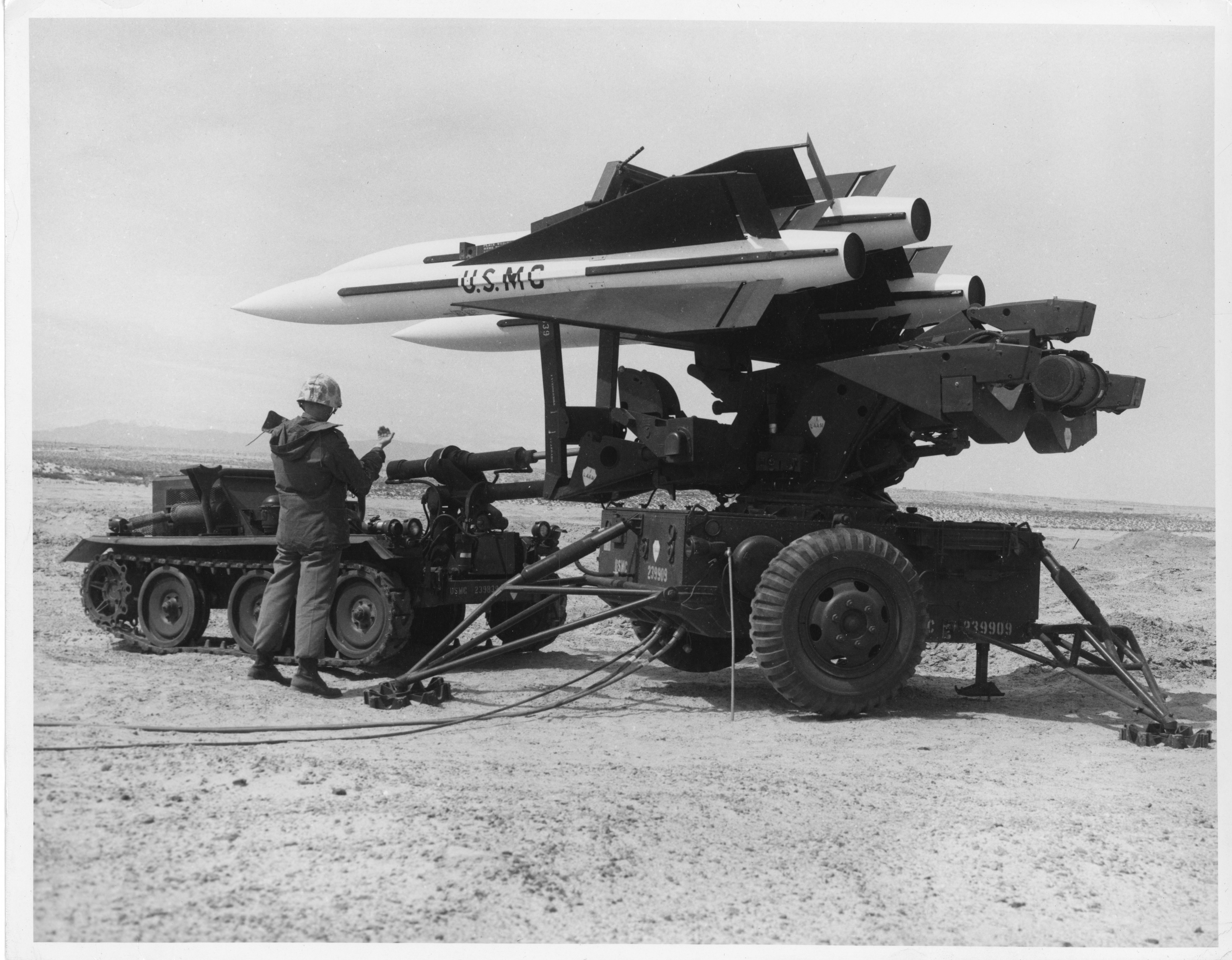
A Marines Hawk crew loads three missiles onto a launcher using a tracked loader-transporter at Twentynine Palms in 1961.
CREDIT: Official U.S. Marine Corps photo, by SSgt L. A. Pope, Archives, Marine Corps History Division, Quantico, VA.
Once fielded, Terrier’s shortcomings came to light. Designed to engage flying targets over water, the system had problems detecting and intercepting low-flying targets from ground clutter (radar signals that reflect off terrain and vegetation and obscure targets) over land. Another drawback was that Terrier could engage only one target at a time, sufficient only if hostile aircraft were neither too fast nor too numerous.4 The size and weight of Terrier’s components were a detriment too. Officially labeled as a mobile weapon system, the Terrier was more transportable than mobile. Its large, bulky components, especially the launchers (weighing 19 tons), were cumbersome to move, particularly when loading onto a ship or landing on a beach. During an amphibious exercise conducted off the coast of southern California in 1960, the launchers barely fit into the landing craft with several hours needed to transfer just one launcher from the landing ship to the landing craft. On top of that, the system needed the better part of a day to emplace and become operational.5 While Terrier did usher the Marine Corps air defense into the Missile Age, its utility to expeditionary operations was too limited, and after just six years of service, it was replaced by the Hawk missile system in 1961.
The Hawk Missile System
The Hawk (homing all the way killer) missile system was designed and manufactured for the U.S. Army and Marine Corps by Raytheon in the mid-to late 1950s. To the Marine Corps, Hawk offered an air defense weapon that could engage supersonic aircraft flying from tree-top level to 11,500 meters (38,000 feet) and at a much longer range—32 km—than the Terrier system. It could also move rapidly from one place to another and emplace and be ready to fire within 45 minutes. All major pieces of equipment were small and light enough for easy transport by ship, landing craft, helicopter, fixed-winged transport aircraft, amphibious vehicle, or truck.
Hawk’s main components were its radars, fire control equipment, launchers, and missiles.6 A pulse acquisition radar detected aircraft flying at medium altitude up to 100 km, and a continuous wave acquisition radar (CWAR) detected aircraft flying close to the ground to a range of 40 km. Once a target was detected, one of the system’s two low power illuminator radars (a.k.a. illuminators), tracked targets with electromagnetic energy that provided guidance for the missiles during their flight. A fifth radar, the range-only radar, was used to overcome enemy electronic jamming during target engagement. For fire control, the primary unit was the battery control central (BCC), a large equipment shelter carried by a 2.5-ton cargo truck. The BCC housed the crew consoles, radarscopes, status displays, and controls needed to operate the system during tactical operations. A secondary fire control unit, the assault fire command console (AFCC) was a compact version of the BCC. Housed in a man-portable 450-pound equipment case, it had a radar display, the electronic controls to operate the CWAR acquisition radar, and an illuminator with three launchers. This stripped-down part of the Hawk system, called an assault fire unit, was transportable by helicopter and could operate independently of the rest of the Hawk system while still providing an effective capability to shoot down low-flying aircraft. Detaching and deploying the assault fire unit gave a missile battery the ability to extend air defense coverage over a larger area or maintain the ability to engage aircraft while the rest of the Hawk system moved to new location.
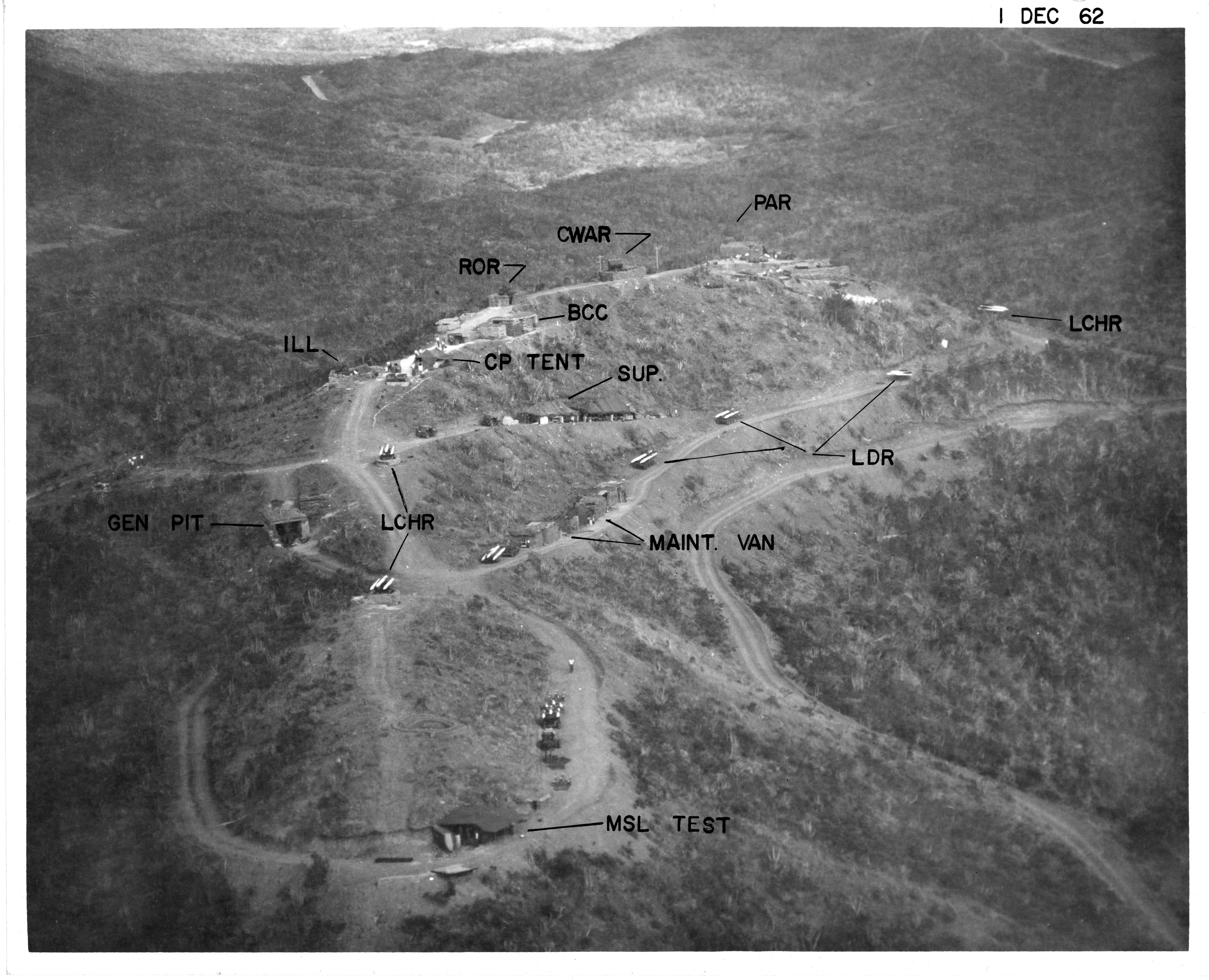
Battery C, 3d Light Antiaircraft Missile Battalion’s, site on John Paul Jones Hill, Guantánamo Bay. Note: PAR=pulse acquisition radar, CWAR=continuous wave acquisition radar, ROR=range-only radar, ILL=illuminator, BCC=battery control central, CP tent=command post tent, SUP=supply, GEN PIT=generator pit, LCHR=launcher, LDR=loader, MAINT VAN=maintenance van, and MSL TEST=missile test set. Official Department of Defense photo
For firepower, a Hawk system had six missile launchers, each armed with three supersonic missiles. When operationally deployed, a Hawk battery typically had 36 missiles: 18 loaded on launchers and another 18 stored on either truck- or trailer-mounted missile storage pallets. Two self-propelled, tracked loader-transporters were used to reload launchers. Three launchers operated with each illuminator, so with its two illuminators, the Hawk system could engage two targets simultaneously. Ancillary equipment included five 45-kilowatt diesel generators; 30 cables to interconnect the radars, control units, and launchers and to provide power from the generators; two junction boxes to control operations of the launchers; and a trailer-mounted guided missile equipment shop for missile assembly, checkout, and maintenance. For mobility, Hawk’s radars and launchers were mounted on wheeled trailers towed by 2.5-ton cargo trucks. To move a complete Hawk system with missiles required 23 trucks, while the smaller AFU needed just 6.7
LAAM Battalions
At the end of the 1950s, the Marine Corps had three air defense battalions stationed at Marine Corps Base Twentynine Palms: the 1st Antiaircraft Artillery (AA) Battalion, formed in 1953 and equipped with Skysweeper guns, and the 1st and 2d Medium Antiaircraft Missile (MAAM) Battalions, which were activated in 1956 and 1958 respectively and equipped with Terrier missile systems. Additionally, several Skysweeper batteries were stationed across the nation in the Marine Corps Reserve.
In 1960, the Marine Corps began transitioning to Hawk by converting its Skyweeper and Terrier units into Hawk missile battalions. Each battalion—designated as a LAAM battalion—was organized with Headquarters and Service Battery and four firing batteries. The Headquarters and Service Battery performed command, administrative, logistic, and maintenance functions for the battalion. The firing batteries, each equipped with one Hawk system, had personnel, vehicles, and equipment required to support and operate the system. The assigned strength of a firing battery was about 150 Marines, while a battalion had nearly 600 Marines.
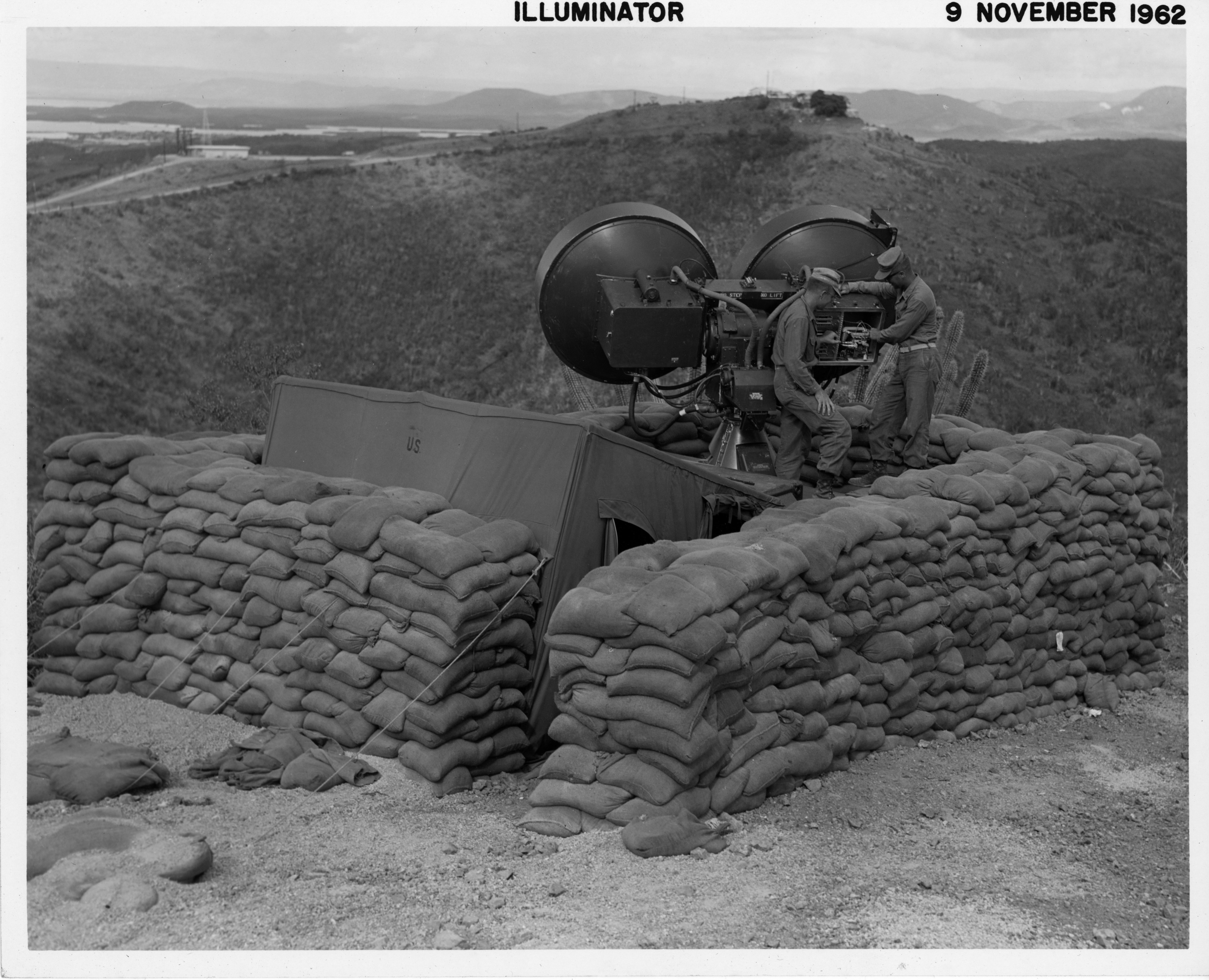
Crewmen performing periodic checks and maintenance on one of Battery C’s two illuminator radars. In the distance is the hill where MAG-32 emplaced its long-range air search radar. Official Department of Defense photo
The first Hawk battalion was formed in May 1960 by redesignating the 1st AA Battalion to the 1st LAAM Battalion.8 After redesignation, 1st AA Battalion’s Headquarters and Service Battery and four firing batteries remained in place, and most leaders and troops were reassigned to 1st LAAM Battalion, then retrained and re-equipped to operate and support the Hawk missile system. For training, Hawk personnel attended the U.S. Army Guided Missile School at Fort Bliss, Texas, a process that was initiated well before 1st LAAM was even activated. Only four months after activation, the battalion successfully fired missiles at Fort Bliss and was declared operational in September 1960.9
The next Hawk battalion—the 2d LAAM—was activated three months after the 1st LAAM Battalion.10 Unlike 1st LAAM, which was formed from an existing air defense battalion, 2d LAAM was created from the ground up by incrementally activating the batteries one at a time, starting with Headquarters and Service Battery and then the four firing batteries, until the battalion reached full strength. The battalion’s training program was the same as that of the 1st LAAM, however, a longer period—seven months—was needed to organize and train the firing batteries, which were declared operational in February 1961.11
Now, with two operational Hawk battalions and a cadre of Hawk experts, the Marine Corps established its own live-fire Hawk missile range at Twentynine Palms and created a program to train Marines assigned to the LAAM units by using equipment and personnel from the 1st and 2d LAAM Battalions.12 The program was also used to retrain three California-based Reserve 75mm antiaircraft batteries to Hawk firing batteries, and eventually grew to become an interbattalion Hawk school that provided instruction previously given by the Army at Fort Bliss.13
In December 1961, 3d LAAM Battalion was formed from the 1st MAAM Battalion.14 After activation, the battalion exchanged its Terrier missile systems for Hawk equipment and Terrier’s service with the Marine Corps came to an end. Along with 1st LAAM’s formation, all LAAM battalions were reorganized by replacing their fourth firing batteries (Battery D) with the Reserve Hawk firing batteries that were created from the three California-based 75mm antiaircraft batteries.15 The 3d LAAM Battalion trained exclusively at Twentynine Palms and became operational in March 1962 after each battery successfully live-fired missiles.16
All three active LAAM battalions were stationed at Twentynine Palms and placed under command of Force Troops, Fleet Marine Force, Pacific (FMF Pacific). Plans were made to move 1st LAAM Battalion to Okinawa and 2d LAAM to Camp Lejeune, North Carolina, but the transfers never occurred.17 On Twentynine Palms, the battalions’ garrison areas were located adjacent to each other with each battalion having its own headquarters and orderly room buildings, barracks, mess halls, billets, motor pools, and a Hawk tactical park where the equipment was emplaced for maintenance and operation. As much as possible, the batteries kept their equipment packed and uploaded in case of alert.18
Once operational, each LAAM battalion established a training program to prepare for possible contingency deployment. Battalion-level training included mobility alerts and movements called mount outs, field exercises, and missile firings. Because the Hawk system was new to the Marine Corps, these exercises were also used to pioneer techniques and procedures for uploading Hawk equipment on GV-1 transport aircraft (designated as the Lockheed C-130 Hercules by the Air Force), airlift by Sikorsky HUS-1 Seahorse helicopter, and employment of the Hawk’s AFCC-equipped assault fire unit. The battalions also participated in major exercises during which firing batteries were airlifted or sealifted to San Clemente and San Nicolas Islands off the coast of California, including an exercise in which Hawk equipment was disembarked at sea and landed on the beach by landing craft. Hawk’s transportability was further exercised when one of 2d LAAM’s firing batteries was flown long-distance from Twentynine Palms to Naval Station Roosevelt Roads, Puerto Rico, to participate in an amphibious operation with Fleet Marine Force, Atlantic. The LAAM battalions also trained with 3d Marine Aircraft Wing during antiair warfare exercises to develop doctrine and procedures for missile and interceptor operations and to test an automated control and coordination system for air and surface-to-air missile units that, unfortunately, was not fielded by the time of the Cuban missile crisis.19 In part, these exercises prompted the Marine Corps to transfer control of the LAAM battalions from Force Troops, FMF Pacific, to Air, FMF Pacific, in May 1962.20
Alert and Deployment
On 18 October 1962, two days after President Kennedy was informed that Soviet nuclear missiles were stationed in Cuba, the Joint Chiefs of Staff directed the Marine Corps to send a LAAM battalion to reinforce Marine forces deploying from Camp Pendleton, California, and Camp Lejuene to Naval Station Guantánamo Bay.21 In turn, two days later, the Commandant of the Marine Corps designated the 3d LAAM as the deploying unit, and the commanding general of Force Troops, FMF Pacific, gave the battalion a verbal order to prepare for deployment by 24 October. To preserve security, the commanding general of Force Troops soon followed the verbal order with a message for 3d LAAM to perform a mount out exercise, giving the battalion a plausible reason for its departure from Twentynine Palms. Now on alert, 3d LAAM initiated a limited (local) recall of battalion personnel while the 1st and 2d LAAM Battalions were placed on standby to support 3d LAAM.22
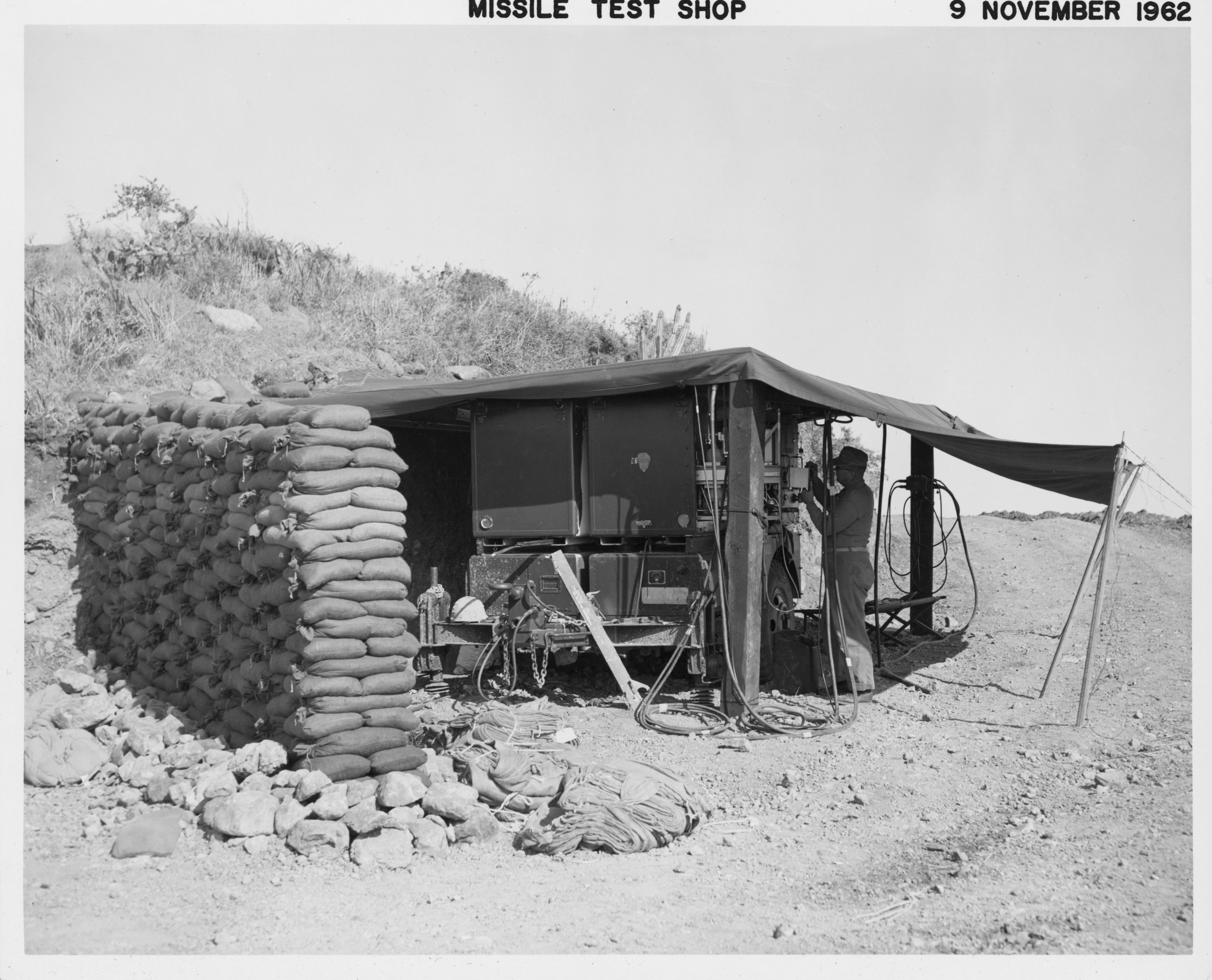
The Hawk system’s trailer-mounted missile test shop was used during missile assembly and checkout to ensure the battery’s missiles were fully operational. Official Department of Defense photo
The next day (Sunday), 3d LAAM’s garrison area became a hub of activity. A full recall of all battalion personnel was initiated with Los Angeles area radio and television stations broadcasting messages for all personnel on liberty or pass to return to their unit.23 The battalion conducted predeployment personnel readiness, packed unit and personal gear, and uploaded equipment onto vehicles. Schools and permanent changes of station were halted, and undeployable Marines were reassigned to one of the other LAAM battalions and then backfilled with Marines from those units. Supplies, spare parts, and equipment were also transferred to 3d LAAM so it could deploy at peak readiness. These activities, especially the sudden transferring of Marines between battalions, caused many unit personnel to realize the alert was not an exercise, and soon rumors of a deployment began circulating around Twentynine Palms.24 Meanwhile, Force Troops notified the battalion that it should expect to execute its deployment sooner than initially ordered.
On Monday, about 48 hours after being alerted, 3d LAAM Battalion departed Twentynine Palms for George Air Force Base, California. Starting with Battery C and the battalion command group, the battalion’s vehicles and equipment convoyed in battery serials the 145 km to the airbase while the rest of the battalion’s Marines were transported by bus.25 As the convoys arrived at George Air Force Base, 3d LAAM staged its equipment and personnel for air transport. Soon, the first Air Force cargo aircraft arrived, and loading commenced at 1800 hours with assistance from 1st LAAM.26 While 3d LAAM’s lead elements were loading onto aircraft, the crisis was heating up. President Kennedy informed the American people about the Soviet missile sites in Cuba and announced the naval blockade. In Cuba, Cuban military forces began mobilizing and occupying wartime positions, including those needed to attack Guantánamo Bay.27 At 2200 hours, the first aircraft departed for Marine Corps Air Station Cherry Point, North Carolina. Only after they were in the air to North Carolina did the Marines of 3d LAAM, except for command and staff, learn that the alert was not an exercise.28
After landing at Cherry Point, the battalion’s equipment was quickly off-loaded from the cargo aircraft, staged by battery, and reconfigured for transport on the smaller Lockheed Martin GV-1 (now KC-130) tanker aircraft to Guantánamo Bay. The airlift from George Air Force Base continued for three more days until Thursday, 25 October. In total, 544 Marines and 1,265 tons of equipment were airlifted by 92 aircraft (86 Douglas C-124 Globemaster II, 2 Douglas C-133 Cargomaster, and 4 Boeing C-135 Stratolifter aircraft). At the same time, the battalion received 72 missiles, enough to fully arm two firing batteries. Shipped inside air-tight metal missile containers, each missile was removed from its container after receipt at Cherry Point, assembled, checked out by the battalion’s missile technicians, and then placed on missile storage pallets for transport to Guantánamo Bay.29
While 3d LAAM prepared for deployment into Guantánamo Bay, the battalion staff attended a conference with the commanding general of FMF Atlantic, where it was decided that one missile battery was sufficient to protect the naval base.30 Battery C, the first battery to land at Cherry Point, was designated to deploy, and an advance party was organized and flown out to Guantánamo Bay on two GV-1 aircraft. Led by a master sergeant, the group comprised about a dozen Marines equipped with a 2.5-ton truck and communications equipment. The GV-1 left Cherry Point late evening on Wednesday, 24 October, the same day that the naval blockade of Cuba commenced. Once in the air, the Marines were issued small arms ammunition and learned their destination was Guantánamo Bay. The flight to Cuba took about three hours. After landing, the advance party occupied and secured the site selected for Battery C. The site was located on the southern peak of John Paul Jones Hill—the highest point on Guantánamo—where it overlooked most of the naval base. For the next two days, the advance party selected locations for the Hawk equipment, coordinated with a Navy construction battalion to build access roads and level positions for the Hawk radars and launchers, and constructed sandbag defensive positions.31
Before leaving Cherry Point, Battery C was augmented by personnel and equipment from Headquarters and Service Battery. These personnel—mainly communications, maintenance, and staff specialists—were sent to perform battalion-level operations and logistics functions that Battery C could not perform on its own.32 The battery was also issued 12 additional missiles (for a total of 48), an extra missile loader-transporter, and three Hawk maintenance shop vans from Headquarters and Service Battery containing direct support-level test and repair equipment and repair parts. The battalion commander, Lieutenant Colonel Edward Oglesby, also deployed with the battery. To offset the additional personnel and equipment from Headquarters and Service Battery while minimizing the number of sorties needed for the airlift, Battery C left most of its vehicles behind at Cherry Point. Even so, 24 GV-1 sorties were still needed to fly the battery to Guantánamo Bay.33 After Battery C departed Cherry Point, Battery B’s equipment and personnel were staged for airlift, but the battery never deployed.34
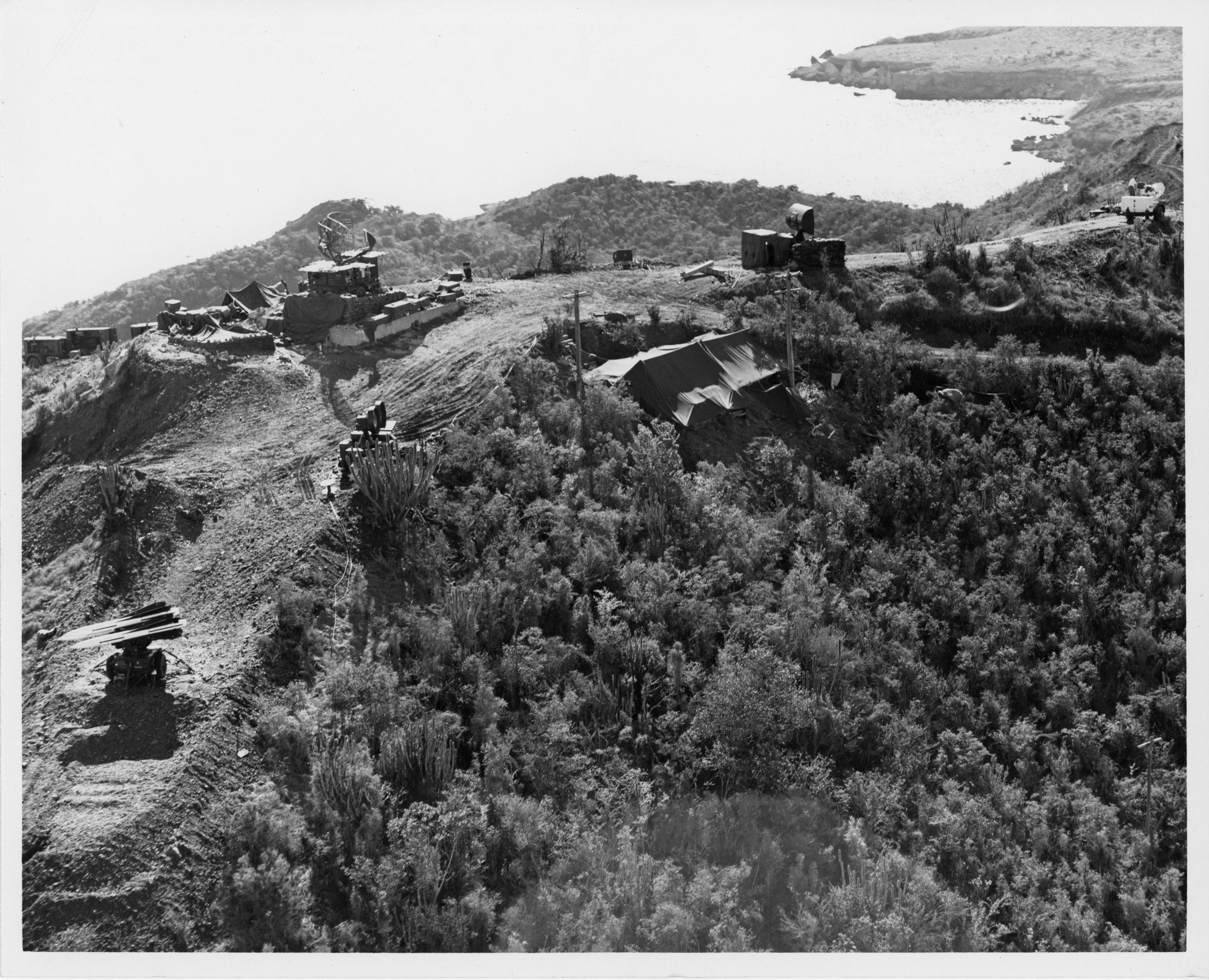
Hawk radars on the apex of John Paul Jones Hill, overlooking the Caribbean Sea. In the background is Blue Beach. Official Department of Defense photo
Guantánamo Bay
The main body of Battery C landed in Guantánamo Bay at McCalla Field on Friday morning, 26 October. The naval base was on high alert, with Marine infantry reinforced by armor and artillery dug in along the boundary line of the base, and naval gunfire support on station offshore.35 Outside of the base, across the rest of the island, Soviet and Cuban forces were completing their preparations for combat.36 After landing, the battery was placed under the operational control of Marine Aircraft Group 32 (MAG-32), which had only recently arrived from Cherry Point to set up an AN/TPS-15 long-range air surveillance radar and a tactical air operations center for coordinating aircraft and surface-to-air missile operations.37 With assistance from the Navy, which provided vehicles and a wrecker to load the BCC and field maintenance shop vans onto 2.5-ton trucks, Battery C moved from the airfield to John Paul Jones Hill. Within a few hours, battery personnel emplaced the Hawk system, brought it to operational status, and went to battle stations with 18 missiles armed and ready to fire.38 The battery’s two acquisition radars were positioned on the apex of the hill with tracking radars and launchers emplaced on opposite ends of the hill, so that one launcher section faced west and the other east. The control units—the BCC and two AFCCs—were placed at the center of the site between the radars and near the battery command post. A Hawk maintenance shop and missile storage area were located along the southern side of the site, below the crest of the hill, where they could not be observed from outside the perimeter of the naval base. Of the battery’s 48 missiles, 18 missiles were on the launchers, 18 were available for immediate reload in the missile storage area, and 12 were stored offsite away from Hawk system. An administrative area with galley and living area was established about 150 meters north of the Hawk system in the direction of main side, although many Marines lived and slept near the Hawk equipment. For command and control, the battery established both wire and radio communications with MAG-32. At first, communications were intermittent because the microwave radio malfunctioned, and nearby Marine units kept accidently cutting the wire lines. The situation was resolved when the senior radio relay technician kicked the radio’s transmitter unit with his boot.39
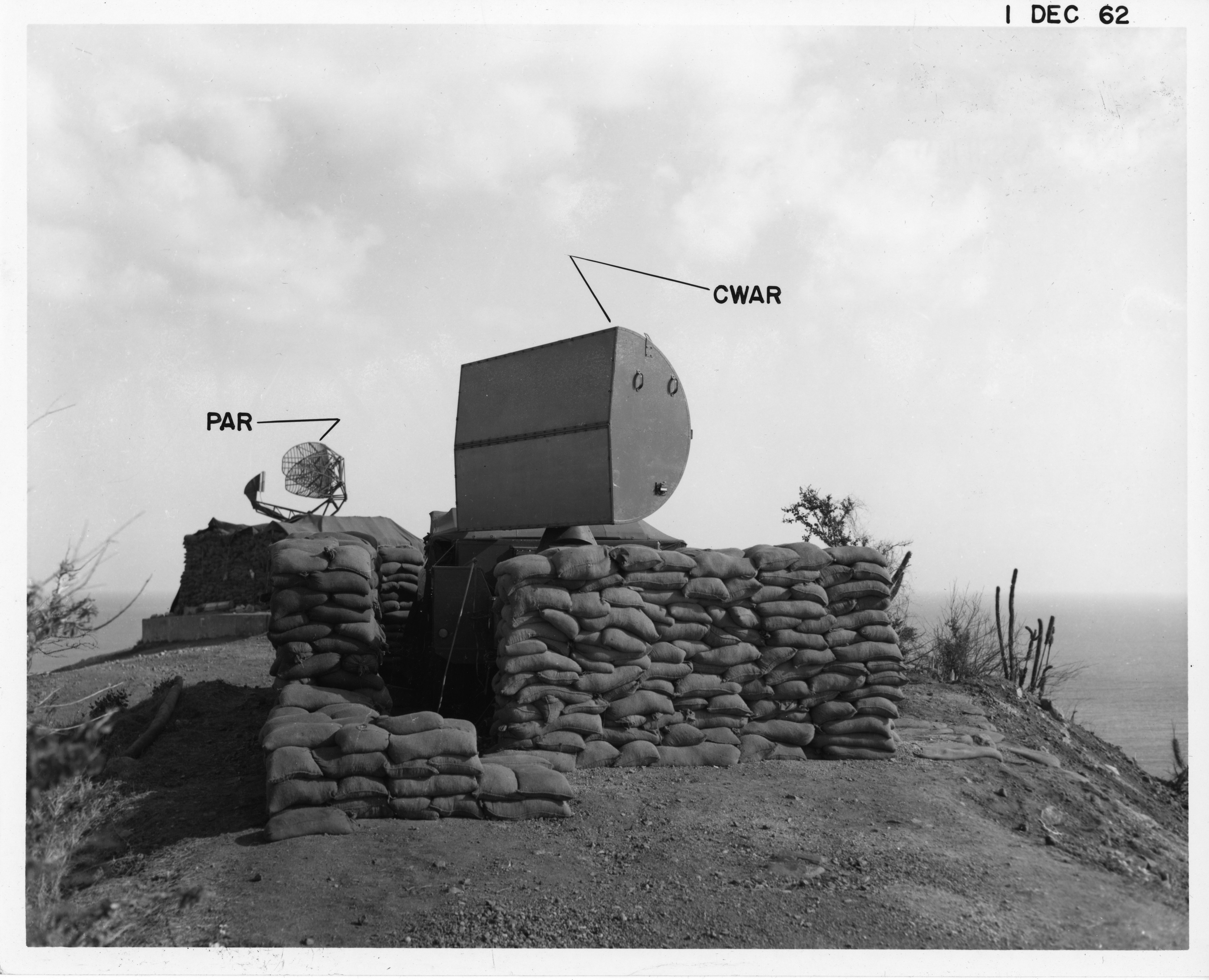
Battery C’s two acquisition radars. The antennas of both radars rotated every three seconds and were easily observed from outside of the naval base’s perimeter. Official Department of Defense photo
From its position, Battery C had radar and missile coverage over all low-altitude approaches to the base, except to the east where several mountains could mask very low-flying aircraft and allow pop-up attacks as close as 15 km from the battery position.40 However, with early warning and aircraft identification information from MAG-32’s AN/TPS-15 radar, which covered the western third of Cuba and surrounding sea out to 290 km, the likelihood of surprise air attack against the naval base was low.41 For an attack on Guantánamo Bay, the Cubans and Soviets had 40 MiG-15, MiG-17, and MiG-19 jet fighters and 42 MiG-21s.42 When armed with conventional bombs and air-to-ground rockets, these MiGs could operate in a ground-attack role. In addition, the Soviets had 42 Ilyushin IL-28 long-range, subsonic jet bombers in various stages of assembly, and none of the nuclear-capable version was operational at the time the crisis came to a head on 27–28 October.43 While formidable in numbers, the performance characteristics of the MiG and IL-28 were well within Hawk’s engagement capabilities, and when combined with Air Force and Navy combat air patrols, the likelihood of a successful mass air attack against Guantánamo Bay was low. However, a simultaneous attack by several small groups of maneuvering aircraft might have had a chance to evade U.S. fighter aircraft and penetrate Battery C’s air defense umbrella.44
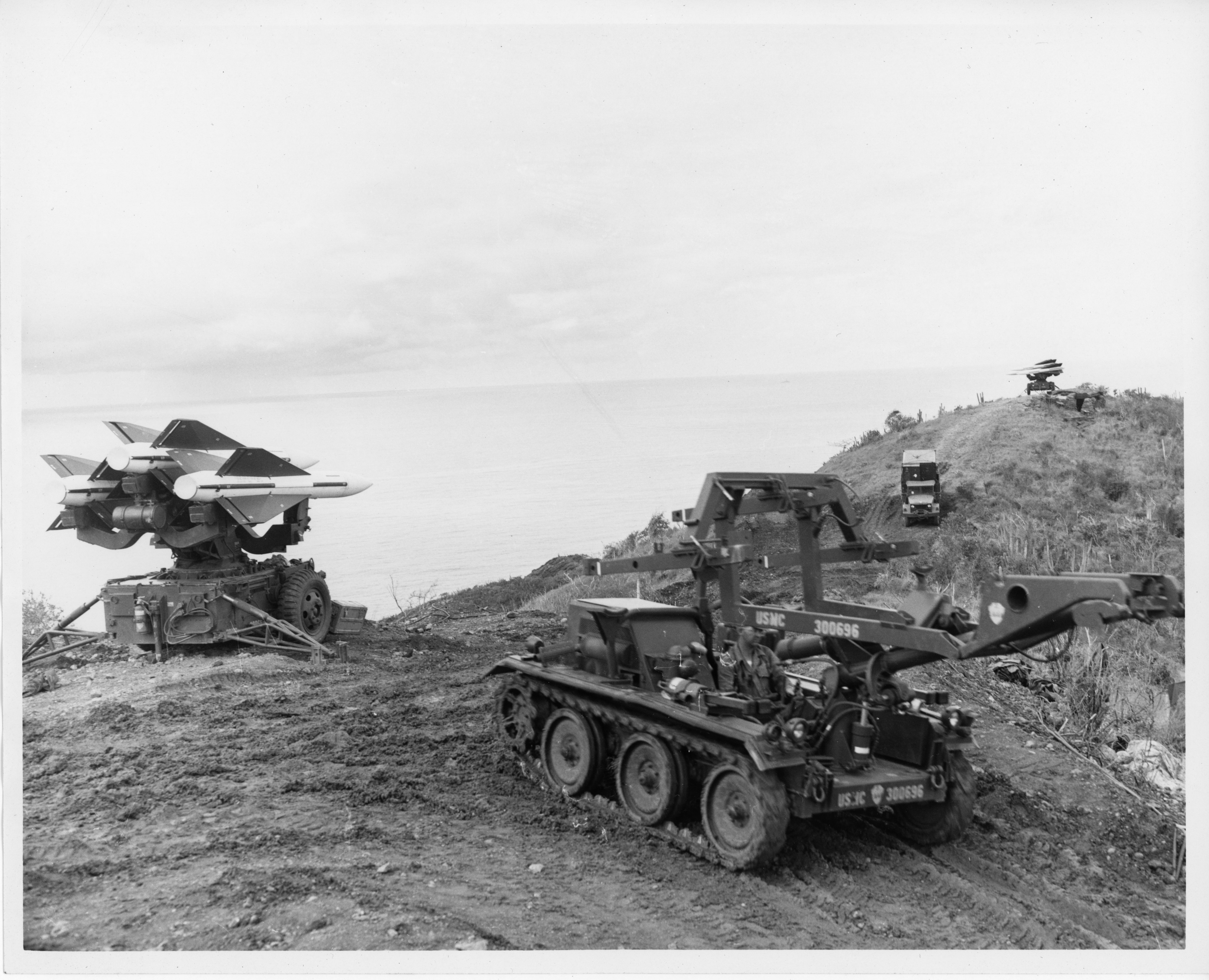
One of Battery C’s two launcher sections. The loader-transporter has just finished transferring missiles a launcher. Official Department of Defense photo
It is not known if the Soviets or Cubans knew about the presence of the Hawk missiles, but at 130 meters above sea level, Battery C was easily visible from outside the naval base. Not only did the site lack natural cover and concealment, but the motion of the radars’ rotating antennas and the white-and-black-painted missiles, stood out starkly against the surrounding terrain and vegetation. Located just 5 km from the base’s perimeter, if ground fighting broke out, Battery C was vulnerable to artillery attack. To improve survivability, battery personnel constructed sandbag revetments to protect the Hawk equipment, even though the revetments would have prevented the battery from quickly moving off John Paul Jones Hill to a different location.
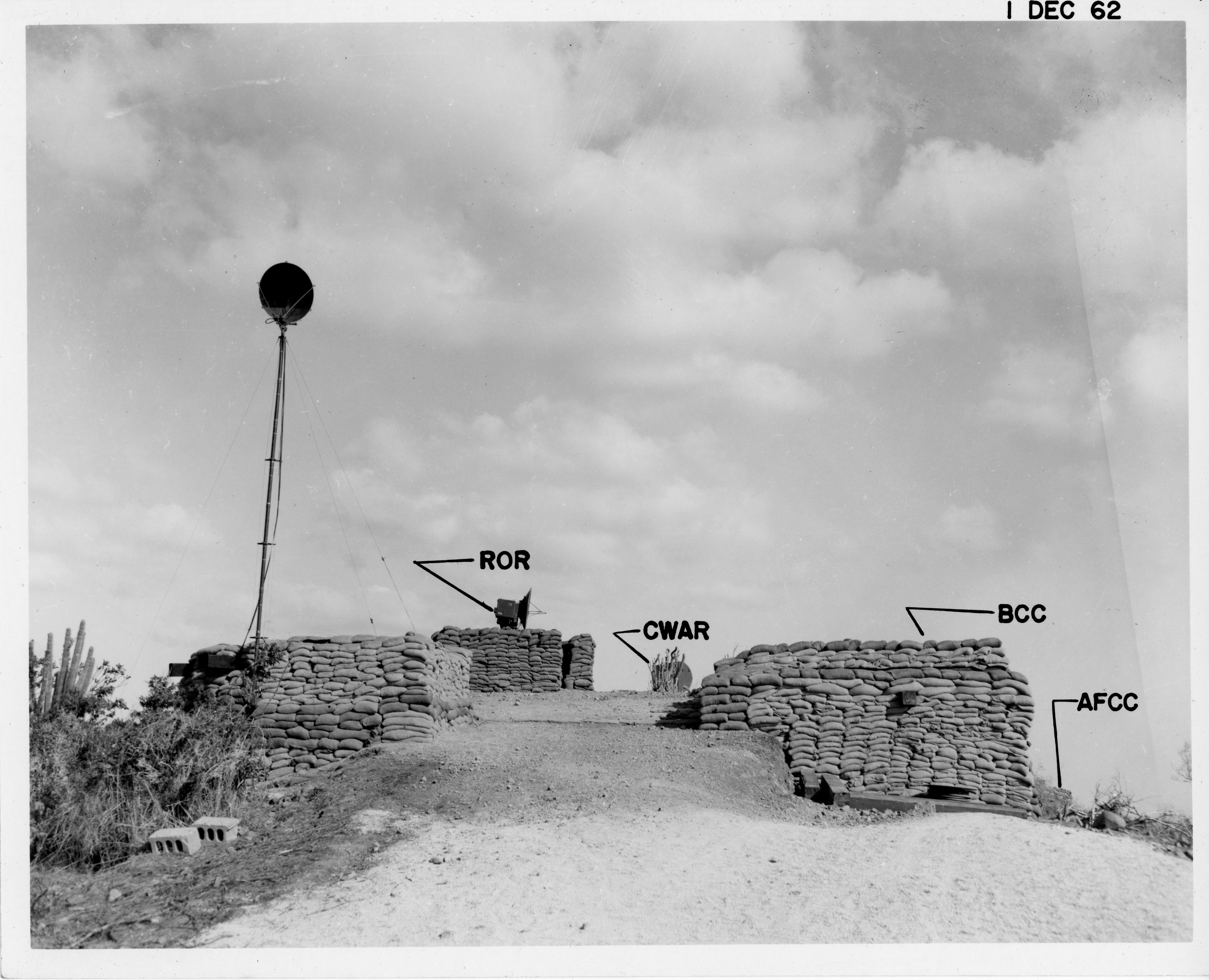
A radio relay system with directional antenna (left) provided communications between MAG-32 and Battery C’s Hawk BCC. In the background are the ROR used for countering enemy electronic jamming and the CWAR for detecting low-flying aircraft. Official Department of Defense photo
The Nuclear Threat
The greatest danger to Guantánamo Bay was Soviet tactical nuclear weapons. Unbeknownst to the U.S. government and military forces, the Soviets had nuclear 2K6 Luna tactical ballistic rockets and Frontoviye Kriatiye Raketi 1 Meteor cruise missiles. The Luna rockets (known by NATO as the FROG-5), were organized into three batteries, each equipped with two launchers and armed with either 2-kiloton nuclear or conventional high-explosive missiles. Stationed in western and central Cuba, some 500 km east of Guantánamo Bay, the Luna rockets with their 32-km range were not a direct threat to Guantánamo Bay. Conversely, two regiments of Meteor missiles, each armed with 8 missile launchers and 40 nuclear missiles, were an immediate threat. The Meteor’s 14-kiloton warhead was similar in explosive power to the bomb dropped on Hiroshima during World War II, and one of the Meteor missile regiments was stationed near Guantánamo Bay, assigned the mission to defeat U.S. amphibious landings in the region and target the Guantánamo naval base.45
On 26 October, as Battery C’s Hawk system became operational, the commander of Soviet forces in Cuba, convinced an American invasion was imminent, ordered two nuclear-capable Meteor missile batteries to move to their firing positions. By early the next morning, one of the batteries was emplaced 30 km west of Guantánamo Bay with its three launchers armed and ready to fire on the naval base.46 As a target for the Hawk missile system, the Meteor missile’s size and flight characteristics were the same as a low-flying jet and well within the Hawk’s engagement capabilities. However, without forewarning that a Soviet missile attack was likely or even possible, it is uncertain that MAG-32 and Battery C, which were using manual fire control procedures, could have reacted fast enough to identify and then engage a Meteor missile launched at such close range. Surprised by the sudden appearance of an inbound missile so close to Guantánamo’s airspace, the Hawk crew, in coordination with MAG-32’s air operations center, would have had about 80 seconds to identify, acquire, and intercept a launched Meteor before it reached the naval station.47 Furthermore, because the Hawk system could engage only two targets at once, if the Soviet Meteor battery salvo-fired its three missiles, then at least one missile could have reached its target before the Hawk system could have destroyed the first two Meteors and engaged the third.
A similar scenario might have played out if the Soviets had deployed Luna rockets in the vicinity of Guantánamo Bay. Though not specifically designed as an antimissile or rocket system, Hawk had proven itself capable of intercepting rockets such as the Luna. During tests in 1960–61, a Hawk missile easily destroyed an MGR-1 Honest John surface-to-surface rocket, which was the ballistic equivalent of the Luna rocket. Yet, unless MAG-32 and Battery C knew about the rockets, it is questionable whether Battery C could have responded successfully.
End of Crisis and Redeployment
The immediate political crisis passed on 28 October when the Soviets agreed to withdraw nuclear missiles from Cuba. Yet, the threat to Guantánamo Bay persisted and U.S. forces remained on alert for another month, until 28 November.48 During that time, Battery C maintained its combat posture. The Hawk system remained at battle stations 24 hours a day; periodic checks and maintenance were performed, readiness drills were conducted, fighting positions were manned, and, to the chagrin of unit personnel, more sandbag revetments were constructed. The constant filling of sandbags left a lasting impression. One young Marine cut a piece of sandbag, trimmed and pinned it as a ribbon on his utility jacket, and said, “Filling sandbags is the only thing we will get credit for.” Soon, the battery settled into a daily routine that resembled a field exercise, and the battery even allowed a few Marines to participate in a rest and relaxation program in San Juan, Puerto Rico, or Montego Bay, Jamaica.49
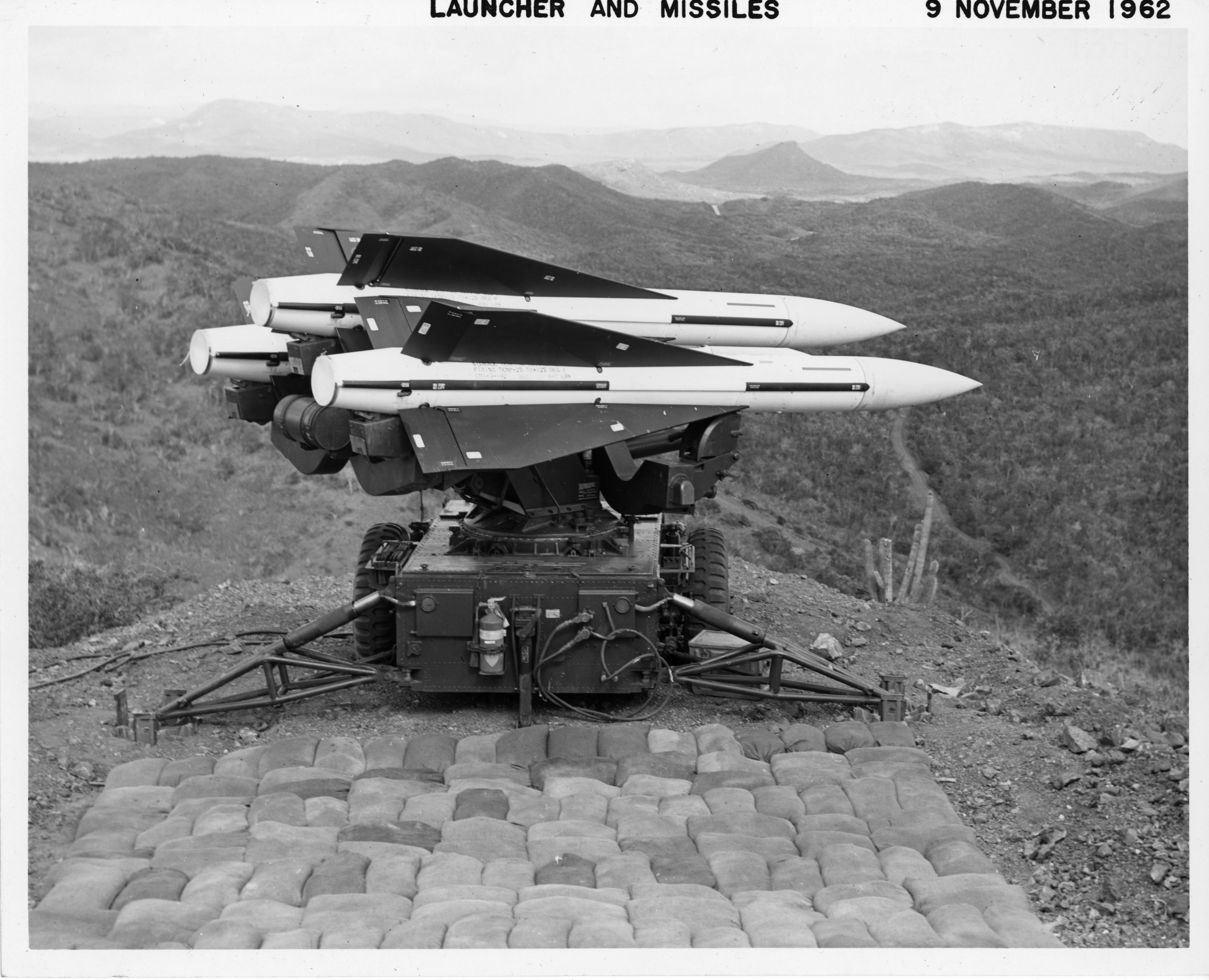
Hawk launcher with three armed and ready-to-fire missiles. Even after the immediate crisis concerning Soviet nuclear weapons was resolved, Battery C remained operational for several weeks before returning to the United States. Official Department of Defense photo
=At the end of November, after Cuban forces demobilized, the commander in chief of the Atlantic Fleet directed forces involved in the Cuban contingency to withdraw.50 With the threat to the naval base diminished, U.S. readiness measures were relaxed, and deployed units began to stand down and return to home stations. Battery C’s turn came a week later, after U.S. intelligence conformed the Soviets had removed the IL-28 bombers from Cuba, and the battery was released from its air defense mission.51 The battery departed Guantánamo on 10 December the same way it had arrived, airlifted via GV-1 cargo aircraft to Cherry Point. The main body left first with most of the unit’s equipment and personnel, followed a few days later by a small rear party. At Cherry Point, 3d LAAM briefly reassembled before officially returning to Twentynine Palms on 13 December. However, the Commandant of the Marine Corps decided to transfer the battalion from FMF Pacific to FMF Atlantic. In anticipation of the transfer, the battalion’s equipment was put in temporary storage, and many of its Marines remained at Cherry Point.52 A month later, 3d LAAM Battalion was officially reassigned to Cherry Point, where soon it settled in and resumed training operations in preparation for the next contingency operation.
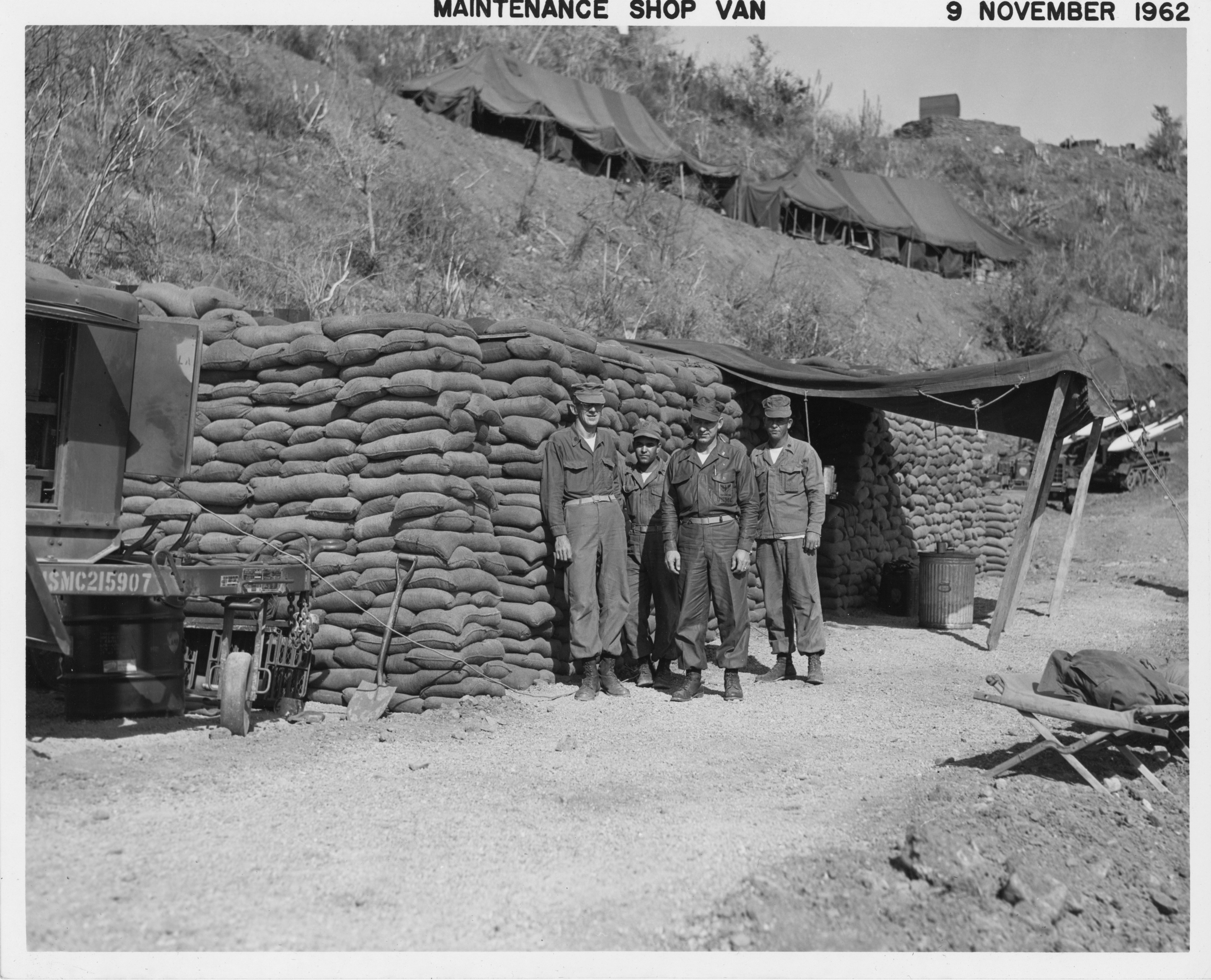
The Hawk system required constant maintenance and repair. Here, a warrant officer and three enlisted Marines stand next to their sandbagged Hawk maintenance shop. Official Department of Defense photo
Just two and a half years after the first LAAM battalion was formed, 3d LAAM’s deployment during the Cuban missile crisis validated the Marine Corps’ decision to field the Hawk missile system. Twice more, the LAAM battalions were called on to rapidly deploy with expeditionary forces. During the Vietnam War, Battery A, 1st LAAM Battalion, became the first U.S. combat unit to enter Vietnam when it was airlifted into Da Nang airbase on 8 February 1965. The rest of the battalion soon followed, and several months later 2d LAAM arrived by ship. During the Gulf War (1990–91), 2d LAAM was the first U.S. air defense unit deployed to the Persian Gulf. Arriving less than two weeks after Iraq invaded Kuwait, the battalion was airlifted into Bahrain and Saudi Arabia, followed several months later by the 3d LAAM Battalion, which deployed by ship.
For four decades, Hawk was the Marine Corps’ primary air defense weapon, but like the Terrier missile system it had replaced in the early 1960s, after the Gulf War it was Hawk’s turn to give way to smaller and more mobile air defense weapons. The air threat to expeditionary forces had changed, and the Marine Corps refocused its ground-based air defense from medium- to low-altitude coverage. By 1997, the Hawk system was retired and the LAAM battalions were deactivated, replaced by Low Altitude Air Defense battalions equipped with short-range FIM-92 Stinger man-portable air defense missile system and Avenger air defense system. The Cold War was over, Hawk’s mission was completed, and the Marine Corps moved into a new age of missile air defense.
•1775•
Endnotes
- Few official records exist of LAAM battalion operations before and during the Cuban missile crisis. Additionally, Marine Corps publications have largely overlooked Hawk prior to the Vietnam War. For this article, the gap was filled by articles from the Marine Corps Base Twentynine Palms newspaper the Observation Post and telephone interviews and email exchanges between the author and seven Marine veterans who served in Hawk missile units before and during the Cuban missile crisis. Unfortunately, because the crisis occurred six decades before this writing, the few officers and senior noncommissioned officers who served with 3d LAAM in the early 1960s, if still alive, are now in their late 80s or early 90s. A search for LAAM veterans found, with one exception, only junior enlisted Marines, no officers.
- Mark L. Morgan and Mark A. Berhow, Rings of Supersonic Steel: Air Defenses of the United States Army 1950–1979—An Introductory History and Site Guide, 2d ed. (San Pedro, CA: Fort MacArthur Military Press, 2002), 28.
- MSgt Robert E. Johnson, “The Vertical Frontier,” Leatherneck, February 1959, 16–23, 65.
- Marion E. Oliver, “Terrier/Tartar: Pacing the Threat,” Johns Hopkins APL Technical Digest 2, no. 4 (1981): 257.
- Sgt Frank Mulder, interview with author, 19 May 2022, hereafter Mulder interview. Sgt Mulder served in a Terrier missile battalion before becoming a Hawk continuous wave radar mechanic in the 3d LAAM Battalion.
- Air Defense Artillery Missile Unit, Hawk (Battalion and Battery), Field Manual (FM) 44-96 (Washington, DC: Headquarters, Department of the Army, 1965), 4–15.
- David A. Anderton, “Army Hawk Anti-Aircraft Missile—Part I,” Aviation Week and Space Technology (4 December 1961): 83.
- Lineage of the 1st Light Antiaircraft Missile Battalion, 4 August 1996, Marine Corps History Division (MCHD), Quantico, VA.
- “Artillery Era Ends: Last AAA 75 Fired,” Observation Post, 28 April 1960; and “Marines Fire Hawk: Final Training Phase,” Observation Post, 21 September 1960.
- Lineage of the 2d Light Antiaircraft Missile Battalion, 10 May 1995, MCHD, Archives Branch, Quantico, VA.
- “Second Hawk Missile Battalion Formed Monday,” Observation Post, 3 August 1960; and “Hawks Activated by Second LAAM’s Troops Return from Fort Bliss,” Observation Post, 15 February 1961.
- “2nd LAAMS in the Limelight,” Observation Post, 2 October 1962.
- “Reserves Train with 1st LAAM,” Observation Post, 15 March 1961; and “Inter-Bn. Hawk School Retrains 3rd LAAM Bn.,” Observation Post, 23 January 1962.
- Lineage of the 3d Light Antiaircraft Missile Battalion, 29 June 1987, MCHD, Archives Branch, Quantico, VA.
- “3rd LAAMs Activated, MAAM Colors Retire,” Observation Post, 5 December 1961; and “LAAM Reserves Fire to Fire Hawk for First Time,” Observation Post, 26 June 1962. The Reserve Hawk batteries completed training in June 1962 and would eventually be reorganized as the 4th LAAM Battalion in the Reserve forces with its headquarters in Fresno, CA.
- “3d LAAMs Fire Hawks,” Observation Post, 3 April 1962.
- “Palms May Get Hawk This June,” Observation Post, 9 February 1960; and Cpl David Young, interview with author, 14 December 2021, hereafter Young interview. Cpl Young, a heavy-duty vehicle mechanic in 1st LAAM Battalion, was present when battalion personnel were informed the battalion was moving to Okinawa.
- Young interview.
- “Hawk Firing Battery Airlifted First Time,” Observation Post, 1 September 1961; “2nd LAAMS Try Receding Shot,” Observation Post, 6 February 1962; “Hawk Story Depicted by ‘C’ Btry., 2nd Bn.,” Observation Post, 6 March 1962; “Anti-Air Warfare Concept Tested by Marines at MCAAS, Yuma,” Flight Jacket, 9 March 1962; “Elements from 2nd LAAM Bn. in Caribbean: Navy-MC Operation,” Observation Post, 24 April 1962; “2nd LAAM’s Detachment Returns after Atlantic Fleet Exercise,” Observation Post, 8 May 1962; “Third LAAM’s Btrys. Travel,” Observation Post, 22 May 1962; “3rd LAAMS to San Nicolas,” Observation Post, 10 July 1962; “3rd LAAMS Goes to Sea; Train with Jet Drones,” Observation Post, 7 August 1962, “2nd LAAMS in the Limelight,” Observation Post, 2 October 1962; and “1st LAAMS Finish One Week Stay at MCAS, Yuma, ARIZ.,” Observation Post, 9 October 1962.
- “HQ Reassigns Hawks; Changes for Infantry,” Observation Post, 20 February 1962.
- Maj John M. Young, USMCR, When the Russians Blinked: The U.S. Maritime Response to the Cuban Missile Crisis (Washington, DC: History and Museums Division, Headquarters Marine Corps, 1990), 132.
- LtCol Edward D. Olgesby, “Letter to Commanding Officer, MWHG-2, Marine Corps Air Station, Cherry Point, North Carolina; Subject: Report of Operations,” 3d Light Antiaircraft Missile Battalion, 11 December 1962, Collection 18951, Marine Corps History Division, Quantico, VA, 1, hereafter Olgesby letter.
- Olgesby letter, 1.
- LtCol Herbert E. Hoppmeyer, interview with author, 30 January 2022. Then-1stLt Hoppmeyer was in 1st MAAM Battalion when it became the 3d LAAM Battalion. At the time of the battalion’s alert, he was an assistant battalion operations officer, but he left the battalion before it deployed.
- Cpl Charles Meany, interview, 16 February 2022, hereafter Meany interview. Then-PFC Meany was a radio relay operator in 3d LAAM Battalion who deployed with Battery C’s advance party to Guantánamo Bay and then served as a vehicle driver for the battalion commander and other officers.
- Young interview. Cpl Young was detailed as a wrecker operator to support 3d LAAM Battalion’s loadout at George Air Force Base.
- Michael Dobbs, One Minute to Midnight: Kennedy, Khrushchev, and Castro on the Brink of Nuclear War (New York: Vintage Books, 2009), 48, 127.
- Cpl G. M. Caldwell, interview with author, 21 May 2022, hereafter Caldwell interview. Cpl Caldwell was a Hawk launcher crewman in Battery B, 3d LAAM Battalion. He was reassigned to Battery C during its deployment in Guantánamo Bay as noncommissioned officer in charge of a launcher.
- Olgesby letter, 2.
- Olgesby letter, 2.
- Meany interview.
- LCpl Thomas DeVogelear, interview with author, 15 November 2021, hereafter DeVogelear interview. LCpl DeVogelear was a radio relay operator in 1st LAAM Battalion. He volunteered to deploy with 3d LAAM Battalion and served with Battery C in Guantánamo Bay.
- Olgesby letter, 2.
- Mulder interview.
- Young, When the Russians Blinked, 132–33.
- Dobbs, One Minute to Midnight, 159–60.
- Young, When the Russians Blinked, 122–23, 132.
- Caldwell interview.
- Cpl Harley Carr, interview with author, 23 March 2022, hereafter Carr interview. Cpl Carr was a radio relay technician in 1st LAAM Battalion and transferred to Battery C, 3d LAAM Battalion, during its deployment to Guantánamo Bay, where he served as the radio relay communications section chief.
- Hawk radar coverage was calculated using the techniques and procedures contained in Air Defense Artillery Missile Unit, Hawk (Battalion and Battery), FM 44-96.
- “Radar Set AN/TPS-15,” in Master Maintenance Reference Manual, TM-2000-15/1 (Washington, DC: Headquarters Marine Corps, 1962), 1 of 8.
- David G. Coleman, “The Missiles of November, December, January, February. . . : The Problem of Acceptable Risk in the Cuban Missile Crisis Settlement,” Journal of Cold War Studies 9, no. 3 (Summer 2007): 16, https://doi.org/10.1162/jcws.2007.9.3.5; and Young, When the Russians Blinked, 106–7, 215.
- Dobbs, One Minute to Midnight, 246–47; and Young, When the Russians Blinked, 24.
- Multiple maneuvering aircraft presented the most challenging engagement scenario for all surface-to-air missile systems, including Hawk, likely requiring Battery C to fire two missiles at each hostile aircraft to ensure its destruction. With 18 missiles on its launchers, Battery C would have had to reload its launchers—an operation that would take about 15 minutes per launcher—after engaging as few as nine aircraft.
- Dino A. Brugioni, “The Invasion of Cuba,” MHQ—The Quarterly Journal of Military History 4, no. 2 (Winter 1992): 96; Coleman, “The Missiles of November, December, January, February…,” 15; and Dobbs, One Minute to Midnight, 248–49.
- Dobbs, One Minute to Midnight, 171, 178–81, 205–6.
- Flying 30 km at a speed of 300 meters per second, Meteor’s flight time from launch to Guantánamo Bay was about 100 seconds. But because the launch position was masked by a hill, neither MAG-32 nor Battery C’s acquisition radars would have detected the missile for its first 10 seconds of flight. Also, the Hawk system’s minimum range shortened engagement time by about 10 seconds, leaving its crew about 80 seconds to detect, acquire, and fire on a Meteor missile.
- Young, When the Russians Blinked, 114, 235.
- Caldwell interview; Carr, interview; and Meany interview.
- Young, When the Russians Blinked, 235.
- Olgesby letter, 2; and Young, When the Russians Blinked, 235–36.
-
Olgesby letter, 2; and Caldwell interview; Carr interview; Meany interview; and DeVogelear interview.